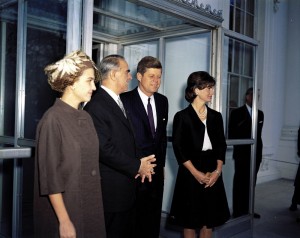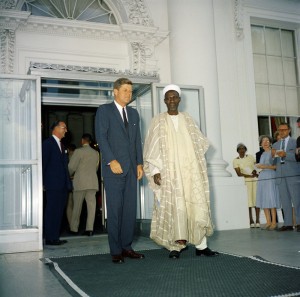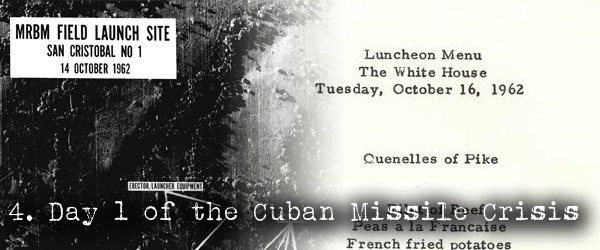
By Joseph Temple
Throughout the Cold War, many of us envisioned the commander-in-chief locked away in an underground bunker, surrounded by maps, radar screens and incoming cables as a major international crisis reached the brink of disaster. However, during the Kennedy administration, while crucial events transpired across the globe, the president wasn’t always at an undisclosed location arguing with his belligerent generals. Instead, there were times when he could be found drinking some of the best wines from Bordeaux and Burgundy at 1600 Pennsylvania Avenue. Even with the option of nuclear war always on the table, the formalities and social responsibilities of being the chief executive—no matter how trivial—rarely stopped.
Special thanks to the JFK Library for providing all the photos and supporting documents for this entry!
blank

On the afternoon of April 17th, 1961, President Kennedy is all smiles as he dines with the Prime Minister of Greece at a White House luncheon. But as he raises his glass of 1952 Dom Pérignon (JFK’s favorite brand of Champagne), an amphibious invasion at the Bay of Pigs unfolds. Enjoying creamy Chicken LaFayette paired with Château Corton Grancey pinot noir, the president’s Greek guests are unaware that 1400 CIA-trained soldiers are struggling to gain a foothold on the beaches of Cuba while they eat. Lacking sufficient air cover, the entire operation goes down in history as an unmitigated disaster—long before the Dame Blanche ice cream and pastry dessert even arrives at JFK’s table.
 |
 |
 |
(Left) President John F. Kennedy and First Lady Jacqueline Kennedy with Prime Minister of Greece Konstantine Karamanlis and Amalia Karamanlis. (Middle) Table setting in the State Dining Room of the White House. (Right) Luncheon menu. (Click to enlarge all)
blank

Following Kennedy’s disastrous meeting with Nikita Khruschev in Vienna, the Cold War suddenly turns red hot when a wall is constructed in order to stop East Germans from fleeing into West Berlin. With many predicting the start of World War III, Kennedy speaks to the nation on the night of July 25th, 1961, promising an increase in military spending to meet this growing threat. But hours before the historic address, a stag luncheon is held in the East Room of the White House for the Prime Minister of Nigeria. Featuring roast sirloin Monegasque, potatoes Parisienne and stuffed tomatoes, a decision is made just days earlier to switch champagnes to compliment the Pêches Melba dessert. So while the cement dries on the Berlin Wall, Perrier-Jouët English Cuvee Brut 1952 is replaced with Moet et Chandon Imperial Brut 1955.
 |
 |
 |
(Left) President John F. Kennedy and Prime Minister Abubakar Balewa of Nigeria. (Middle) Tentative menu for the luncheon. (Right) Document requesting a change in the third wine selection. (Click to enlarge all)
blank

The State Dinner honoring Pakistani President Muhammad Ayub Khan, a vital Cold War ally, is unique in that instead of being held at the White House, this event takes place at George Washington’s historic estate on Mount Vernon. While the president may be concerned about a Soviet nuclear attack, event planners have their own enemy to defeat – a merciless army of hundreds of mosquitos. Wreaking havoc with Chef René Verdon’s dishes, the Signal Corps rushes across the Potomac River to curb this growing threat. According to social secretary Letitia Baldrige, everything from the canopied tents to the avocado and crabmeat mimosa is doused with bug spray. Thankfully, no one becomes ill from the decadent mushroom and tomato Poulet Chasseur and Château Haut-Brion Blanc 1958 blanketed with DDT.
Above: Letitia Baldrige recalls the infamous night at Mount Vernon.
blank

As the Cuban Missile Crisis begins, Kennedy and his advisers consider a number of options from a naval quarantine to a full-scale invasion of the island. But on October 16th, 1962, the first of this thirteen-day calamity, the president carries on with his social calendar, giving the impression that everything is business as usual. One of these scheduled events is luncheon with Crown Prince Hasan of Libya, who, like most Americans, is completely unaware of the volatile situation in the Caribbean. Served filet of beef and French fried potatoes, ending with pistachio and orange ice cream for dessert, Kennedy is calm, cool and collected throughout the entire lunch with the Libyan Prince. However, what is missing from the final menu are the wine selections, which could be the result of either the Prince’s Muslim faith or the sobriety of the entire ordeal occurring behind the scenes.
 |
 |
 |
(Left) Document from the Libyan embassy accepting the president’s invitation. (Middle) The tentative menu with the wine selections crossed out. (Right) The finalized menu. (Click to enlarge all)
blank
blank
Sources:
Dallek, Robert. An Unfinished Life: John F. Kennedy, 1917–1963. New York: Little, Brown and Company, 2003.
You might also like:
 |
 |
 |